Eid al-Fitr
Eid al-Fitr (/iːd əl ˈfɪtər/ eed əl FIT-ər; Arabic: عيد الفطر ʻĪd al-Fiṭr, IPA: [ʕiːd al fitˤr]),[3] (sometimes known as Eid ul-Fitr), also called the "Festival of Breaking the Fast", is a religious holiday celebrated by Muslims worldwide that marks the end of the month-long dawn-to-sunset fasting of Ramadan.[4] This religious Eid is the only day in the month of Shawwal during which Muslims are not permitted to fast. The date for the start of any lunar Hijri month varies based on when the new moon is sighted by local religious authorities, so the day of celebration varies by locality. The holiday is widely called Korité in West Africa.
| Eid al-Fitr | |
|---|---|
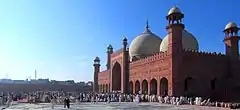 Eid prayers at Badshahi Mosque, in Lahore, Pakistan | |
| Official name | Arabic: عيد الفطر, romanized: ‘Īd al-Fiṭr |
| Observed by | Muslims |
| Type | Islamic |
| Significance | Marks the end of fasting in Ramadan |
| Celebrations | Eid prayers, charity, social gatherings, festive meals, gift-giving |
| Date | 1 Shawwal[1] |
| 2020 date | 24 May |
| 2021 date | 13 May (expected[1][2] – may differ 1 day dependent on sighting of lunar crescent) |
| Related to | Ramadan, Eid al-Adha |
 |
| Part of a series on |
| Islamic culture |
|---|
| Architecture |
| Art |
| Clothing |
| Holidays |
| Literature |
| Music |
| Theatre |
|
Eid al-Fitr has a particular salat (Islamic prayer) that consists of two rakats (units) generally performed in an open field or large hall. It may only be performed in congregation (jamāʿat) and features six additional Takbirs (raising of the hands to the ears while saying "Allāhu ʾAkbar", meaning "God is the greatest") in the Hanafi school of Sunni Islam: three at the start of the first rakat and three just before rukūʿ in the second rakat.[5] Other Sunni schools usually have twelve Takbirs, similarly split in groups of seven and five. In Shia Islam, the salat has six Takbirs in the first rakat at the end of qira'a, before rukūʿ, and five in the second.[6] Depending on the juristic opinion of the locality, this salat is either farḍ فرض (obligatory), mustaḥabb مستحب (strongly recommended) or mandūb مندوب (preferable).
History
Eid al-Fitr was originated by the Islamic prophet Muhammad. According to certain traditions, these festivals were initiated in Medina after the migration of Muhammad from Mecca. Anas, a well-known companion of the Prophet, narrated that, when the Prophet arrived in Medina, he found people celebrating two specific days in which they entertained themselves with recreation and merriment. At this, the Prophet remarked that Almighty has fixed two days of festivity instead of these for you which are better than these: Eid al-Fitr and Eid al-Adha.[7]
General rituals
Traditionally, Eid al-Fitr begins at sunset on the night of the first sighting of the crescent moon. If the moon is not observed immediately after the 29th day of the previous lunar month (either because clouds block its view or because the western sky is still too bright when the moon sets), then the holiday is celebrated the following day.[8] Eid al-Fitr is celebrated for one to three days, depending on the country.[9] It is forbidden to fast on the Day of Eid, and a specific prayer is nominated for this day.[10] As an obligatory act of charity, money is paid to the poor and the needy (Arabic: Zakat-ul-fitr) before performing the ‘Eid prayer.[11]

Eid prayer and eidgah
The Eid prayer is performed in congregation in open areas like fields, community centers, or mosques.[9] No call to prayer is given for this Eid prayer, and it consists of only two units of prayer with a variable amount of Takbirs and other prayer elements depending on the branch of Islam observed.The Eid prayer is followed by the sermon and then a supplication asking for Allah's forgiveness, mercy, peace and blessings for all living beings across the world. The sermon also instructs Muslims as to the performance of rituals of Eid, such as the zakat.[12] The sermon of Eid takes place after the Eid prayer, unlike Friday prayer which comes first before prayer. Some imams believe that listening to the sermon at Eid is optional.[13] After the prayers, Muslims visit their relatives, friends, and acquaintances or hold large communal celebrations in homes, community centers, or rented halls.[9]
.jpg.webp)
Sunni procedure
As ritual dictates, Sunnis praise Allah in a loud voice while going to the Eid prayer: Allāhu Akbar, Allāhu Akbar, Allāhu Akbar. Lā ilāha illà l-Lāh wal-Lāhu akbar, Allahu akbar walil-Lāhi l-ḥamd. Recitation ceases when they get to the place of Eid or once the Imam commences activities.[14]
The prayer starts by doing "Niyyat" for the prayer and then Takbir is said by the Imam and his followers. Next, "Takbeer-e-Tehreema" is recited, followed by Allahu Akbar three times, raising hands to the ears and dropping them each time, except for the last when the hands are folded. Then the Imam reads the Surah-e-Fatiha and other Surah. Then the congregation performs Ruku and Sujud as in other prayers. This completes the first rakat. The congregation rises up and folds their hands for the second rakat., during which the Imam recites Surah Fatiha and another Surah. After this, three Takbirs are called out just before the Ruku, each time raising hands to the ears and dropping them. For the fourth time, the congregation says Allah o Akbar and subsequently goes into the Ruku. The rest of the prayer is completed in the regular manner. This completes the Eid prayer. After the prayer there is a khutbah.[15]

Shia procedure
Prayer starts with the Niyyat followed by five Takbirs. During every Takbir of the first rakat, a special Dua is recited. Then, the Imam recites Sūrat al-Fātiḥah and Surat Al-'A`lá and the congregation performs Ruku and Sujud as in other prayers. In the second Rakat, the same above steps (five Takbeers, Sūrat al-Fātiḥah and Surat Al-'A`lá, Ruku and Sujud) are repeated. After the prayer, Khutbah starts.[16]
Practices by country
Jordan
Jordanians decorate their homes and prepare sumptuous meals for family and friends. They prepare new clothes and shoes for the festival. Eid festivities in Jordan may vary culturally depending on the region, but one common thread in all celebrations is generosity and hospitality. It is a common Jordanian tradition for families to gather at the patriarchal home after the Eid prayers. Before the special Eid meal is served, young children will line up in front of each adult family member, who dispense money as gifts to the children.
Saudi Arabia
Saudis decorate their homes and prepare sumptuous meals for family and friends. They prepare new clothes and shoes for the festival. Eid festivities in Saudi Arabia may vary culturally depending on the region, but one common thread in all celebrations is generosity and hospitality. It is a common Saudi tradition for families to gather at the patriarchal home after the Eid prayers. Before the special Eid meal is served, young children will line up in front of each adult family member, who dispense money as gifts to the children.[17]
Iran
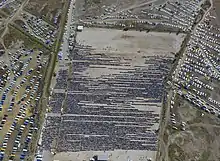
In Iran, at the last days of the month of Ramadan, several groups of experts representing the office of Ayatollah Khamenei go to the different zones of the country to determine the date of Eid al-Fitr.[18] Iranian Muslims take part in the Eid al-Fitr prayer and pay the Zakat al-Fitr.[19] The Eid al-Fitr prayer, and the following sermon, has been led by Ayatollah Seyyed Ali Khamenei, Supreme Leader of Iran, at Tehran's Imam Khomeini Grand Prayer Grounds (Mossalla).[20] The celebration is typically marked by a one- or two-day national holiday.[21]
Turkey
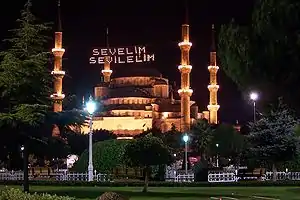
In Turkey, nationwide celebrated holidays are referred to as bayram, and Eid al-Fitr is referred to as both Şeker Bayramı ("Bayram of Sweets") and Ramazan Bayramı ("Ramadan Bayram"). It is a time for people to attend prayer services, put on their best clothes (referred to as bayramlık, often purchased just for the occasion), visit all their loved ones (such as relatives, neighbors, and friends), and pay their respects to the deceased with organised visits to cemeteries. It is also customary for young children to go around their neighborhood, door to door, and wish everyone a "Happy Bayram", for which they are awarded candy, chocolates, traditional sweets such as baklava and Turkish Delight, or a small amount of money at every door.[22]
Afghanistan
In the predominantly Sunni Muslim culture of Afghanistan, Eid al-Fitr holds significant importance and is celebrated widely for three days. The most common greeting is Kochnai Akhtar (Blessed Eid) in the Pashto-speaking community. Afghans start preparing for the Eid al-Fitr festival up to ten days prior by cleaning their homes (called Khana Takani in Dari). Afghans visit their local bazaars to buy new clothes, sweets, and snacks including Jelabi (Jalebi), Shor-Nakhod (made with chickpeas), and Cake wa Kolcha (a simple cake, similar to pound cake). On the day of Eid al-Fitr, Afghans will first offer their Eid prayers and then gather in their homes with their families, greeting one another by saying "Eid Mubarak" and usually adding "Eidet Mobarak Roza wa Namazet Qabool Dakhel Hajiha wa Ghaziha," which means "Happy Eid to you; may your fasting and prayers be accepted by Allah, and may you be counted among those who will go to the Hajj-pilgrimage." Family elders will give money and gifts to children. It is also common practice to visit families and friends, which may be difficult to do at other times of the year. Children walk from home to home saying "Khala Eidet Mubarak" ("aunt happy Eid"), and they receive cookies or Pala. At night, multiple campfires are set around houses, sometimes to the point that entire valleys may initially appear to be engulfed in flame. Celebratory fire with automatic rifles, particularly tracer rounds, can also be expected in high density.[23]
Egypt
Egyptians spend the first day of Eid al-Fitr to gather all family members and celebrate the Eid at public gardens. It is customary for children to also receive an Eidi, a small sum of money to be spent on activities throughout the Eid.[24] Egyptians like to celebrate with others, so the streets are always crowded during the days and nights of Eid.[25]
Heightened incidence of sexual assault during Eid al-Fitr
There were several accounts of a heightened number of sexual assaults and rapes during the 2006 Egyptian Eid.[26][27][28][29] Subsequent reports indicated that the phenomenon continued to grow in following years.[30][31][32][33] One Egyptian journalist wrote "The Eid al-Fitr holiday following this year's Ramadan brought its usual share of sexual harassment".[34] Operation Anti Sexual Harassment, an Egyptian organisation founded to protect against sexual assaults, described Eid al-Fitr as a "season for harassment",[35] and the prevalence of such attacks "a trend that has become associated with Eid al-Fitr celebrations in recent years".[32] Despite this rise, sexual assault and "intrigue" with women during Eid al-Fitr dates back to the early 19th century, as Edward Lane alludes to.[36] In 2013, allegations, the discussion of which was considered taboo,[37] surfaced in Cairo and Tanta.[38][39][40] 2014 saw lower rates of attempted harassment, and activists reported more confidence since the amendment of the penal code.[41] 141 police reports for harassment were filed in Cairo in 2015, though this number may underestimate the issue as many reports were reportedly withdrawn.[42] Despite a reduction to 120 complaints and 35 arrests for harassment in 2016,[43] many women still find it necessary to take significant precautions during Eid.[44] 2018 showed continued evidence of reduction.[45]

Tunisia
Since 2012, Tunisia celebrates Eid for three days (with preparations starting several days earlier), two of which are national holidays. Special biscuits, including Baklawa and several kinds of "ka'ak", are made to give to friends and relatives on the day.[46]
Somalia
.jpg.webp)
In Somalia and other Islamic parts of the Horn region, Eid al-Fitr is observed by the Muslim communities. Celebrations marking the event are typically accompanied by elaborate banquets, where special dishes such as xalwo (halwo) and buskut (buskuit) are served.[47]
South Africa
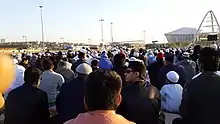
In Cape Town, hundreds of Muslims—each with something to share with others at the time of the breaking of the fast—gather at Green Point in the evening of the last day of Ramadan for the sighting of the moon. The Maghrib (sunset) prayer is then performed in congregation and the formal moon-sighting results are announced thereafter.[48]
Sudan
In Sudan, where 97% of the population is Muslim,[49] preparations for Eid begin the last few days of Ramadan. For days, ka'ak (sugar powdered cookies), bettifour (dry baked goods including dainty biscuits, baked meringues and macaroons—whose name are derived from the French petit four), and popcorn are baked in large batches to serve to guests and to give to family and friends; dressy Eid clothes are either shopped for or sewn; girls and women decorate their hands and feet with henna; and parts of the house may even be painted. The night before Eid, the whole household partakes in cleaning the house and yard and setting out the finest bedsheets, table cloths, and decorations. On the day of Eid, men and boys (and occasionally women and girls) will attend the Eid prayer. For the next 3 days, families will then visit each other, extended family, neighbors, and close friends. In these short visits, the baked goods, chocolates, and sweets are served, and often large lunches are prepared for the visiting well-wishers. Children are given gifts, either in the form of toys or money.[50]
India

Special celebratory dishes in India include Lachcha or sivayyan, a dish of fine, toasted sweet vermicelli noodles with milk and dried fruit (see Sheer khurma).[51]
Pakistan
In Pakistan, Eid al-Fitr is also referred to as چھوٹی عید, chhotī īd, 'the Lesser Eid' or میٹھی عید, mīṭhī īd, 'Sweet Eid'.[52] People are supposed to give obligatory charity on behalf of each of their family members to the needy or poor before Eid day or, at most, before the Eid prayer, allowing for all to share in the joy of Eid. At home, family members enjoy special Eid breakfast with various types of sweets and desserts, including Kheer and the traditional dessert Sheer Khurma, which is made of vermicelli, milk, butter, dry fruits, and dates. Eid is mainly enjoyed by the kids, as they mostly receive money in cash called "Eidi" as gift from their relatives and elders.[53] People tend to get fresh and crisp banknotes to gift children with. State Bank of Pakistan issues fresh currency notes every year for this purpose.[54]
Bangladesh
The preparation for Eid in Bangladesh starts from the last quarter of the holy month of Ramadan. The markets and shopping malls become overwhelmed with people. Those who live away from their families for their job or livelihood, they return to their home towns and villages to celebrate the festival with family members and relatives. In the Chaand Raat children gather at the open field to see the Hilal (crescent moon) of the month of Shawwal. Girls decorate their hands with Mehndi. Like other South Asian countries, Lachcha (Vermicelli) are served with Roti as breakfast in Bangladesh. Then people attend the Eid prayer in Eidgah. Children do salam by touching the legs of the elderly members of the family. And elders give them a small amount of money which is known as "Salami" or "Eidi (gift)", which is a major part of Eid happiness for children. Delicious dishes like Biryani, Polao, Korma etc are served in the dining table. Wealthy Muslims in Bangladesh also distribute Zakat alms to the poor people. People visit the house of relatives and greet each other saying "Eid Mubarak" (Happy Eid).[55]

Indonesia
Eid is known in Indonesia as Hari Raya Idul Fitri, or more popularly as Lebaran, and is a national holiday.[56] People return to their home town or city (an exodus known as mudik) to celebrate with their families and to ask forgiveness from parents, in-laws, and other elders.[57] Festivities start the night before with chanting the Takbir and lighting lamps. On the day itself, after Eid prayer in the morning, zakat alms for the poor are distributed in the mosques. People gather with family and neighbors in traditional clothing and have a special Lebaran meal. Children are given money in colourful envelopes.[58] Later, it is common for Muslims in Indonesia to visit the graves of relatives to ritually clean the grave. Muslims also visit the living in a special ritual called Halal bi-Halal sometime during or several days after Idul Fitri.[59]
Malaysia, Singapore, Brunei, Indonesia and Thailand
In Malaysia, Singapore, Brunei, Indonesia and Thailand, children are given token sums of money, known as "duit raya" also known as green envelope, from their parents or elders.[60][61]
Myanmar
During Ramadan, in small towns and big villages with significant Muslim populations, Burmese Muslim youth organize singing teams called Jago (meaning "wake up). Jago teams usually do not use musical instruments apart from the occasional use of harmonica mouth organs.[62] The roving groups of singers will take the tunes of popular Hindi movie songs, replaced with Burmese lyrics and invocations about fasting, the principles of Islam, and the benefits of Salat.[63]
Philippines
Among Muslim Filipinos in the Philippines, Eid al-Fitr is commonly known as Hariraya, Buka, Hariraya Buka, or Hariraya Buka Puasa.[64][65][66] It is also known as Wakas ng Ramadan (literally "End of Ramadan"), Araw ng Raya ("Feast Day"), or Pagtatapos ng Pag-aayuno ("End of the Fast") in Filipino. It was proclaimed a legal holiday for Muslim Filipinos in 1977 by Presidential Decree 1083. In 2002, this was upgraded to a public national holiday by Republic Act 9177. It is also sometimes known by its Malay name "Hari Raya Puasa"; and by its Indonesian name "Lebaran".[67][68][69]
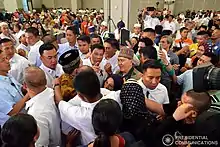
Its beginning is decided by the sighting of the crescent moon (hilal), followed by morning prayers in mosques or public plazas.[70] When this occurs can sometimes differ depending on the regional government. In some places it is based on the physical sighting of the hilal; while in others it is determined by the Regional Darul Ifta’ of Bangsamoro (RDI-BARMM) or the National Commission on Muslim Filipinos (NCMF), especially during cloudy days.[64][71][72]
The sighting of the hilal is traditionally marked by the beating of drums in some regions. In modern times, this has evolved into a noise barrage known as "Mobile Takbir", where celebrants, especially youths, rev their motorcycles or honk their horns while driving through the streets. Guns are also sometimes fired. These practices have been discouraged by the Grand Mufti of Bangsamoro and local government officials as not being in accordance with Islamic teachings as well as being dangerous and causing accidents in the past.[72][73][74]
Hariraya is characterized by the giving of gifts (known as Eidi), food sharing (salu-salo), and visiting the elderly and the sick.[74][75] Food, alms, and basic necessities are also donated to the poor, a practice known as Fitrana or Zakat al-Fitr. This is usually done a day before Eid al-Fitr.[67][76] Various traditional sweet delicacies of the different Muslim Filipino ethnic groups are served for breakfast, including daral, dodol, browas, tinagtag, panyalam, jampok, and so on.[77] Various activities also mark the celebrations, including dancing, boat races, horse races, and carabao fighting in cities and towns with significant Muslim populations. In Metro Manila, the celebrations are usually held at the Manila Golden Mosque and the Quirino Grandstand.[70] The celebration lasts for three days.[71]
China
In the People's Republic of China, out of 56 officially recognized ethnic groups, Eid al-Fitr is celebrated by at least 10 ethnic groups that are predominantly Muslim. These groups are said to total 18 million according to official statistics, but some observers say the actual number may be much higher. It is also a public holiday in China in certain regions, including two Province Prefecture Level regions, Ningxia and Xinjiang. All residents in these areas, regardless of religion, are entitled to either a one-day or three-day official holiday. Outside the Muslim-majority regions, only Muslims are entitled to a one-day holiday. In Xinjiang province, Eid al-Fitr is even celebrated by the Han Chinese population. During the holiday, supplies of mutton, lamb and beef are distributed to households as part of a welfare program funded by government agencies, public and private institutions, and businesses. In Yunnan, Muslim populations are spread throughout the region. On Eid al-Fitr, however, some devotees may travel to Sayyid 'Ajjal's grave after their communal prayers. There, they will conduct readings from the Quran and clean the tomb, reminiscent of the historic annual Chinese Qingming festival, in which people go to their ancestors' graves, sweep and clean the area, and make food offerings. Finally the accomplishments of the Sayyid 'Ajall will be related in story form, concluded by a special prayer service to honour the hundreds of thousands of Muslims killed during the Panthay Rebellion, and the hundreds killed during the Cultural Revolution.[78]
Greece
Eid al-Fitr (i.e. Seker Bayram, Sugar Feast) is celebrated in Greece mainly in the Western Thrace region from the local Muslim minority (Turks, Pomaks and Roma), along with the other two major celebrations, Kurban Bayram (Sacrifice Feast) and Hıdırellez. On the day of the Bayram, family gathers together, wear their best clothes, and celebrate with a common meal, after attending the morning prayer. The women prepare and offer sweets to family and visitors, while small children go around and pay their respects to the elderly by kissing their hands. The elder in turn reward them with candies, sweets, and small amounts of money.[79][80] Local Muslim shopkeepers close their shops this day, while Muslim minority schools have a 5-day holiday for the feast.[80] Some entertainment venues and clubs hold special events for the night of the Bayram.[81]
United Kingdom
Although Eid al-Fitr is not a recognized public holiday in the United Kingdom,[82] many schools, businesses, and organisations allow for at least a day's leave to be taken for religious celebrations.[83][84]
United States
In New York City, alternate side parking (street cleaning) regulations are suspended on Eid. Beginning in 2016, New York City Public Schools also remain closed on Eid.[85] In Houston, Texas, the annual prayers are offered at the George R. Brown Convention Center in downtown Houston, organised by the Islamic Society of Greater Houston (ISGH). In other states, with smaller Muslim populations, it is common that schools will remain open on Eid al-Fitr.
The United States Postal Service (USPS) has issued several Eid postage stamps, across several years—starting in 2001—honoring "two of the most important festivals in the Islamic calendar: Eid al-Fitr and Eid al-Adha." Eid stamps were released in 2001 – 2002, 2006 – 2009, 2011.[86][87][88][89]
In the Gregorian calendar
Although the date of Eid al-Fitr is always the same in the Islamic calendar, the date in the Gregorian calendar falls approximately 11 days earlier each successive year, since the Islamic calendar is lunar and the Gregorian calendar is solar. Hence if the Eid falls in the first ten days of a Gregorian calendar year, there will be a second Eid in the last ten days of the same Gregorian calendar year, as happened in 2000 CE. The Gregorian date may vary between countries depending on the local visibility of the new moon. Some expatriate Muslim communities follow the dates as determined for their home country, while others follow the local dates of their country of residence.
The following table shows predicted dates and announced dates based on new moon sightings for Saudi Arabia.[1][90]
| Islamic year | Umm al-Qura predicted | High Judiciary Council of Saudi Arabia announced |
|---|---|---|
| 1415 | 3 March 1995 | 3 March 1995 |
| 1416 | 20 February 1996 | 20 February 1996 |
| 1417 | 9 February 1997 | 9 February 1997 |
| 1418 | 30 January 1998 | 30 January 1998 |
| 1419 | 19 January 1999 | 19 January 1999 |
| 1420 | 8 January 2000 | 8 January 2000 |
| 1421 | 27 December 2000 | 27 December 2000 |
| 1422 | 16 December 2001 | 16 December 2001 |
| 1423 | 5 December 2002 | 5 December 2002 |
| 1424 | 25 November 2003 | 25 November 2003 |
| 1425 | 14 November 2004 | 13 November 2004 |
| 1426 | 3 November 2005 | 3 November 2005 |
| 1427 | 23 October 2006 | 23 October 2006 |
| 1428 | 13 October 2007 | 12 October 2007 |
| 1429 | 1 October 2008 | 30 September 2008 |
| 1430 | 20 September 2009 | 20 September 2009 |
| 1431 | 10 September 2010 | 10 September 2010 |
| 1432 | 30 August 2011 | 30 August 2011 |
| 1433 | 19 August 2012 | 19 August 2012 |
| 1434 | 8 August 2013 | 8 August 2013 |
| 1435 | 28 July 2014 | 28 July 2014 |
| 1436 | 17 July 2015 | 17 July 2015 |
| 1437 | 6 July 2016 | 6 July 2016 |
| 1438 | 25 June 2017 | 25 June 2017 |
| 1439 | 15 June 2018 | 15 June 2018[91] |
| 1440 | 4 June 2019 | 4 June 2019[92] |
| 1441 | 24 May 2020 | 24 May 2020 [93] |
| 1442 | 13 May 2021 | |
| 1443 | 2 May 2022 | |
| 1444 | 21 April 2023 | |
| 1445 | 10 April 2024 | |
| 1446 | 30 March 2025 | |
| 1447 | 20 March 2026 | |
| 1448 | 9 March 2027 | |
| 1449 | 26 February 2028 | |
| 1450 | 14 February 2029 |
Gallery
 The first Mughal Emperor Babur greets courtiers during the Eid al-Fitr festival
The first Mughal Emperor Babur greets courtiers during the Eid al-Fitr festival Eid al-Fitr mass prayer at Delhi's Jama Masjid
Eid al-Fitr mass prayer at Delhi's Jama Masjid Muslims in Britain performing the Eid prayers during the celebration, 1941
Muslims in Britain performing the Eid prayers during the celebration, 1941
 Muslims in Singapore celebrating Eid al-Fitr
Muslims in Singapore celebrating Eid al-Fitr An Indonesian family celebrating lebaran with various culinary dishes specific to this holiday
An Indonesian family celebrating lebaran with various culinary dishes specific to this holiday
See also
Citations
- "The Umm al-Qura Calendar of Saudi Arabia". uu.nl. Archived from the original on 11 June 2011. Retrieved 7 March 2017.
- Gent, R.H. van. "The Umm al-Qura Calendar of Saudi Arabia – adjustment". Archived from the original on 23 July 2015. Retrieved 2 February 2021.
- Elias, Jamal J. (1999). Islam. Routledge. p. 75. ISBN 0415211654.
- Barr, Sabrina. "EID AL-ADHA 2019: WHEN IS IT, HOW IS IT CELEBRATED AND HOW TO WISH SOMEONE A HAPPY EID". independent. Archived from the original on 11 August 2019. Retrieved 11 August 2019.
- "Eid al-Fitr and the six supplementary fasts of Shawwal". Inter-islam.org. Archived from the original on 26 July 2013. Retrieved 11 August 2013.
- Namaz (prayer) Eid Fitr Archived 13 February 2018 at the Wayback Machine yjc.ir Retrieved 4 June 2018
- Ahmad ibn Hanbal, Musnad, vol. 4, 141–142, (no. 13210).
- Adewunmi, Bim. "When is Eid 2014? It could be Monday or Tuesday, it might be Sunday". The Guardian. Archived from the original on 26 July 2014. Retrieved 25 July 2014.
- "Eid al-Fitr 2019: Everything you need to know". Al Jazeera. Archived from the original on 3 June 2019. Retrieved 4 June 2019.
- Heiligman, Deborah (2009). Celebrate Ramadan and Eid al-Fitr with Praying, Fasting, and Charity. National Geographic Children's Books. ISBN 978-0792259268.
- "Articles and FAQs about Islam, Muslims". Islamicfinder.org. Archived from the original on 28 August 2013. Retrieved 11 August 2013.
- Gaffney, Patrick D. "Khutba." Encyclopedia of Islam and the Muslim World. p. 394.
- "Eid Gebete". Diegebetszeiten.de (in German). 7 January 2020.
- Mufti Taqi Usmani. "Shawwal: On Eid Night, Eid Day, and During the Month". Albalagh.net. Archived from the original on 16 August 2013. Retrieved 11 August 2013.
- "نحوه خواندن نماز عید فطر در اهل سنت". mizanonline. Archived from the original on 25 September 2018. Retrieved 12 December 2019.
- "Eid al-Fitr prayer in Shia Islam". fardanews. Archived from the original on 16 June 2019. Retrieved 12 December 2019.
- "Eid in Saudi Arabia's Hijaz region marked by family reunions". arabnews. Archived from the original on 4 June 2019. Retrieved 3 June 2019.
- "Wednesday announced as Eid al-Fitr in Iran". Mehr News Agency. Archived from the original on 8 July 2016. Retrieved 6 July 2016.
- "Iranians Celebrate Eid al-Fitr". Tasnim News Agency. Archived from the original on 7 July 2016. Retrieved 6 July 2016.
- "Tehran Eid al-Fitr prayers to be led by Supreme Leader". IRNA. Archived from the original on 5 July 2016. Retrieved 6 July 2016.
- Mamouri, Ali. "Eid al-Fitr: religious celebration and cultural marker". Al-Monitor. Archived from the original on 22 August 2016. Retrieved 6 July 2016.
- Bayar, Gozde. "Turkey celebrates Eid al-Fitr". aaNews. Archived from the original on 8 June 2019. Retrieved 4 June 2019.
- "نگاهی به آداب و رسوم بزرگداشت عید سعید فطر در افغانستان". avapress. Archived from the original on 10 December 2019. Retrieved 10 December 2019.
- "Where Egyptians spend 1st day of Eid al-Fitr?". Egypt Today. Archived from the original on 8 June 2019. Retrieved 5 June 2019.
- "Egypt's Eid: Celebration for the Young and Old". Tour Egypt. Archived from the original on 24 October 2011. Retrieved 21 August 2011.
- "Cairo street crowds target women". BBC News. 1 November 2006. Archived from the original on 5 October 2013. Retrieved 13 August 2013.
- "The Widespread Plague of Sexual Harassment in Egypt". Al Akhbar English. 20 September 2012. Archived from the original on 5 August 2013. Retrieved 11 August 2013.
- Ali, Mohammed (21 October 2008). "Taking on Sexual Harassment, a Social Phenomenon in Egypt". Al Jadid Magazine. Archived from the original on 5 August 2013. Retrieved 11 August 2013.
- "Sexual Harassment Takes Center Stage Again in Egypt". Ikhwanweb. Muslim Brotherhood. 5 July 2007. Archived from the original on 5 October 2013. Retrieved 11 August 2013.
- "Unsafe streets". Al-Ahram Weekly Online. 15 October 2008. Archived from the original on 5 August 2013. Retrieved 11 August 2013.
- "The latest developments of the case of sexual harassment in Cairo". World Pulse. 29 October 2012. Archived from the original on 5 August 2013. Retrieved 11 August 2013.
- "Sexual assaults in Egypt mar Eid holiday". Al Arabiya. 5 October 2008. Archived from the original on 13 August 2013. Retrieved 12 August 2013.
- "Movement plans patrols to counter sexual harassment during Eid". Egypt Independent. 17 September 2012. Archived from the original on 13 August 2013. Retrieved 13 August 2013.
- "Egypt is starting to take sexual harassment seriously". The Guardian. 5 September 2012. Archived from the original on 13 August 2013. Retrieved 13 August 2013.
- "Several arrested as sexual harassment surges in Cairo". Egypt Independent. 21 August 2012. Archived from the original on 13 August 2013. Retrieved 13 August 2013.
- Lane, Edward (1836). Manners and Customs of the Modern Egyptians. New York: Cosimo Classics. ISBN 1-59605-161-2.
- "Sex Harassment Is Off-Topic for Egyptian Ramadan". Women's eNews. 30 June 2014. Archived from the original on 29 July 2014. Retrieved 22 July 2014.
- "'I witnessed harassment' volunteers catch 8–10 yr olds in the act". Ahram Online. 9 August 2013. Archived from the original on 10 August 2013. Retrieved 11 August 2013.
- "Egypt activists try to stop holiday sex harassment". USA Today. 26 October 2013. Archived from the original on 17 January 2018. Retrieved 24 March 2014.
- "Victim of harassment killed in Tanta: Shoft Taharosh group continues monitoring sexual harassment during Eid". Daily News Egypt. 10 August 2013. Archived from the original on 13 August 2013. Retrieved 13 August 2013.
- "Anti-sexual harassment initiative intervenes in 35 incidents during Eid". Daily News Egypt. 31 July 2014. Archived from the original on 12 December 2014. Retrieved 1 August 2014.
- "141 sexual harassment incidents reported in 3 days during Eid al-Fitr: NCW". The Cairo Post. 20 July 2015. Archived from the original on 22 July 2015. Retrieved 22 July 2015.
- "Egypt reports drop in sexual harassment during Eid". Gulf News. 8 July 2016. Archived from the original on 8 July 2016. Retrieved 8 July 2016.
- "Risk of sex attack fills women with dread during Eid al-Fitr vacation". Egypt Independent. 5 July 2016. Archived from the original on 8 July 2016. Retrieved 8 July 2016.
- "Sexual Harassment Cases in Egypt Drop This Eid Holidays". Al Bawaba. 20 June 2018. Archived from the original on 30 June 2018. Retrieved 20 June 2018.
- Canli, Enes. "Kaak: Tunisia's quintessential Eid al-Fitr dessert". Anadolu Agency. Archived from the original on 27 November 2019. Retrieved 27 November 2019.
- Barlin Ali, Somali Cuisine, (AuthorHouse: 2007), p. 79
- "Moonsighting on Monday". 91.3FM Voice of the Cape. 27 August 2011. Archived from the original on 27 May 2013. Retrieved 11 August 2013.
- "About Sudan". United Nations Development Programme. 9 January 2011. Archived from the original on 23 January 2014. Retrieved 11 August 2013.
- Eltigani, Nour. "Eid al-Fitr with a Sudanese flavor". egypt today. Archived from the original on 27 June 2017. Retrieved 25 June 2017.
- "Food Events – Eid Celebrations". BBC Food Online. Archived from the original on 11 January 2010.
- Niazi, M A (9 August 2013). "A 'Lesser Eid'". The Nation. Pakistan: The Nation. Retrieved 30 June 2020.
In the subcontinent, this Eid, Eid-ul-Fitr, is known as ‘Choti Eid’, or the ‘Lesser Eid’.
- "Eid al-Fitr celebrated in Pakistan with religious zeal". IRNA. Archived from the original on 7 June 2019. Retrieved 5 July 2019.
- "Here's How to Get Fresh Currency Notes from SBP via SMS". Retrieved 21 May 2020.
- "How people celebrate Eid-al-Fitr (Eid) in Bangladesh".
- Watson, Todd (4 August 2013). "Indonesia prepares for Idul Fitri". Inside Investor. Archived from the original on 5 August 2013. Retrieved 7 August 2013.
- "Govt says roads ready for Lebaran exodus". The Jakarta Post. 1 September 2010. Archived from the original on 10 May 2013. Retrieved 11 August 2013.
- "آداب و رسوم کشورهای مسلمان در عید فطر". isna. Archived from the original on 10 December 2019. Retrieved 10 December 2019.
- van Doorn-Harder, Nelly. "Southeast Asian culture and Islam". Encyclopedia of Islam and the Muslim world. p. 649
- "Hari Raya Puasa". All Malaysia.info. Archived from the original on 3 February 2008.
- Yusof, Mimi Syed; Hafeez, Shahrul (30 October 2005). "When Raya was a bewildering experience". New Straits Times. p. 8. Archived from the original on 24 September 2015 – via HighBeam Research.
- Neikbanzaw magazine, No. 1 & 2, December 1952 & 1953
- Interview by Khin Khin Yie with Haji U Bar Bar @ U Win Maung, composer of Jago songs, 28x81 street Mandalay. Published in Prophet Muhammad's Day Golden Jubilee magazine page 88, column 2 paragraph 2
- Lidasan, Mussolini S. (10 June 2019). "To Eid or not to Eid, again". SunStar Cagayan de Oro. Retrieved 15 January 2020.
- McKenna, Thomas M. (1998). Muslim Rulers and Rebels: Everyday Politics and Armed Separatism in the Southern Philippines. University of California Press. p. 43. ISBN 9780520210165.
- Pendatun, Datu Shariff Khaled Ada. "What You Need to Know About Eid al Fitr". Spot.ph. Retrieved 15 January 2020.
- Tan, Nigel (5 June 2019). "FAST FACTS: What you should know about Eid al-Fitr, end of Ramadan". Rappler. Retrieved 15 January 2020.
- Vila, Alixandra Caole (29 July 2014). "Celebrating Eid al-Fitr around the table". PhilStar Global. Retrieved 15 January 2020.
- Raslan, Karim (10 June 2019). "OPINION: What it's like to celebrate Eid al-Fitr in a Muslim minority country". ABS-CBN News. Retrieved 15 January 2020.
- "Hari Raya". Tagalog Lang. Retrieved 15 January 2020.
- "10 Things You May Not Know About Eid al-Fitr". ChoosePhilippines. Retrieved 15 January 2020.
- Cabrera, Ferdinandh B. (4 June 2019). "Marawi marks Eid'l Fitr day ahead of date set by Darul Ifta". MindaNews. Retrieved 15 January 2020.
- Rosalado, RJ (3 June 2019). "June 5, 2019 declared as Eid'l Fitr in PH". ABS-CBN News. Retrieved 15 January 2020.
- Jocson, Liza; Cabilbigan, Erwin; Ordonez, Erwin (17 July 2015). "Muslims celebrate Eid'l Fitr". CNN. Retrieved 15 January 2020.
- Fernandez, Edwin O. (5 June 2019). "BARMM celebrates Eid al-Fitr". Philippine Daily Inquirer. Retrieved 15 January 2020.
- "SLIDESHOW: Filipino Muslims celebrate Eid'l Fitr". ABS-CBN News. 15 June 2018. Retrieved 15 January 2020.
- Gunting, Ayunan G. (2 July 2016). "The spirit–and food–of Ramadan". Lifestyle.Inq. Retrieved 15 January 2020.
- Armijo, Jacqueline M. "East Asian culture and Islam." Encyclopedia of Islam and the Muslim world, p. 191
- Relytech, North Cyprus Online. "North Cyprus Tourist Guide". Archived from the original on 19 September 2016. Retrieved 5 July 2016.
- "Μουσουλμάνοι & ΚΛΙΜΑΚΑ: ΗΘΗ ΚΑΙ ΕΘΙΜΑ ΤΩΝ ΕΛΛΗΝΩΝ ΜΟΥΣΟΥΛΜΑΝΩΝ – ΜΕΡΟΣ Α'" (in Greek). mousoulman-klimaka.blogspot.gr. Archived from the original on 16 August 2016. Retrieved 5 July 2016.
- "5 Temmuz 2016–Şeker Gibi Eğlence-My Club*Rzv:6946282655*6973602046*6978124937". facebook.com.
- Bentley, David (19 June 2018). "Should the UK Government make Eid a public holiday?". birminghammail. Retrieved 6 June 2020.
- "How to handle holiday requests for staff celebrating Eid". Peninsula UK. Retrieved 6 June 2020.
- Bentley, David (14 June 2018). "Can children take time off school for Eid? These are the rules". birminghammail. Retrieved 6 June 2020.
- McCarthy, Tom. "New York City adds two Muslim holidays to public school calendar". The Guardian. Archived from the original on 17 July 2015. Retrieved 17 July 2015.
- "2011 USPS Eid Forever stamp, with the quotation about the festivals". US Postal Service. 28 March 2011. Archived from the original on 20 January 2012. Retrieved 11 August 2013.
- "2009 USPS Eid stamp, with mention of other dates". US Postal Service. 28 March 2011. Retrieved 11 August 2013.
- "2008 USPS Eid stamp". US Postal Service. 28 March 2011. Retrieved 11 August 2013.
- "2007 USPS Eid stamp". US Postal Service. 28 March 2011. Retrieved 11 August 2013.
- Gent, R.H. van. "The Umm al-Qura Calendar of Saudi Arabia – adjustment". Archived from the original on 23 July 2015. Retrieved 22 July 2015.
- Saudi confirms start Eid al-Fitr Archived 4 June 2019 at the Wayback Machine, Gulf Business
- Announced Eid al-Fitr in Saudi on Tuesday Archived 4 June 2019 at the Wayback Machine, Gulf News
- "Iran calendar" (PDF). calendar.ut.ac.
General sources
- Encyclopedia of Islam and the Muslim World. Edited by Martin, Richard C. Macmillan Reference, 2004. Vol. 1.
- The Umm al-Qura calendar of Saudi Arabia (with computed and announced dates for Eid al-Fitr)
External links
 Media related to Eid al-Fitr at Wikimedia Commons
Media related to Eid al-Fitr at Wikimedia Commons The dictionary definition of Eid al-Fitr at Wiktionary
The dictionary definition of Eid al-Fitr at Wiktionary





